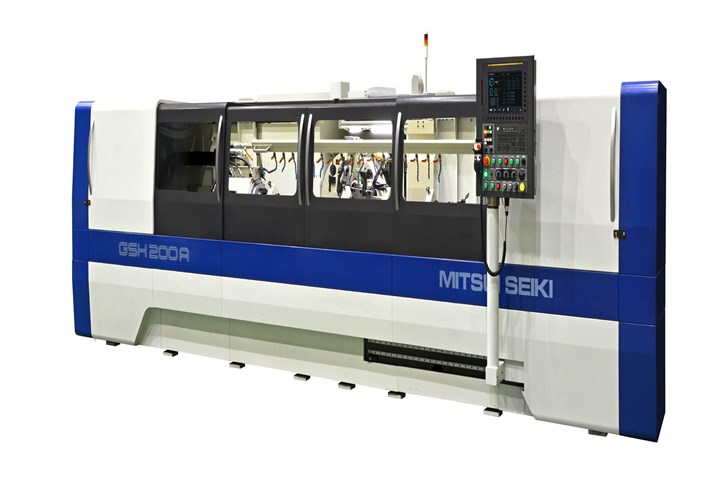Thread Grinding Machine Facilitates Consistent Precision and High Processing Speeds
The Mitsui Seiki GSH 200A has been engineered to handle a wide variety of workpiece sizes and enables flexible application.

Photo Credit: Mitsui Seiki
Mitsui Seiki’s GSH 200A Thread Grinding Machine combines flexible application, high processing speeds and consistent precision to complete an extensive selection of threading jobs. The GSH 200A is said to be engineered to handle a wide variety of workpiece sizes. Maximum diameter swing over the machine table is 480 mm and distance between centers is 2,250 mm, enabling the machine to grind a maximum screw length of 2,000 mm and maximum workpiece diameter of 200 mm.
The machine’s capabilities include a 15-kW, direct-drive motor that produces maximum wheel spindle speed of 6,000 m/min. X-axis stroke of 330 mm features a rapid feed rate of 5 m/min, Z-axis stroke is 2,150 mm with 10m/min rapid feed and maximum work spindle speed is 200 rpm.
The company notes that sliding machine surfaces are hand-scraped to maximize precision. In addition, multiple systems minimize thermal displacement that can affect thread accuracy and consistency. Lubricant in the table feed lead screw and shaft core stabilizes temperatures of those components. A main coolant nozzle cools, lubricates and removes sludge at the grinding point, while separate work area and bed coolant showers equalize internal machine temperatures. Oil and air lubricate and cool grinding wheel axis bearings. The GSH 200A machine is compatible with both oil-based and water-soluble coolant, selectable when the machine is produced.
The GSH 200A permits users to apply CBN as well as standard grinding wheels, facilitating grinding of hardened steels as well as unhardened workpieces. CBN can reportedly grind more than two times faster than standard wheels while providing longer grinding life, which extends the dressing interval and reduces dressing time per workpiece. Maximum diameter for standard wheels is 460 mm and peripheral speed is 60 m/sec, while maximum CBN wheel diameter is 380 mm and peripheral speed 120 m/sec.
The machine’s three-axis NC dresser employs two linear axes (U,W) and one rotary axis (B) to produce highly accurate profiles in both CBN and standard wheels. A disc-type rotary diamond dresser provides significantly longer dresser life than single point diamond.
Automation features on the GSH 200A include an automatic phase adjuster, automatic notch position adjuster and automatic effective diameter adjuster. Together, the features permit an operator to leave the machine rather than remaining there to adjust the steady rest and oblique diameter during the operation. The auto-effective diameter adjuster uses a touch probe to contact the thread groove and measure change in diameter by scanning. An acoustic emissions (AE) sensor built into the wheel spindle provides automatic wheel in-feed position adjustment.
An optional heavy grinding wheel replacement support mechanism facilitates safe and easy grinding wheel and flange changeovers.
The machine’s FANUC 31i-B control features a 375-mm touch panel LCD with new HMI (Human Machine Interface) technology. Users can move the panel to where it is most convenient to operate.
Related Content
-
Solving Mold Alignment Problems with the Right Alignment Lock
Correct alignment lock selection can reduce maintenance costs and molding downtime, as well as increase part quality over the mold’s entire life.
-
Three Good Reasons to Switch from Three- to Five-Axis Machining in Moldmaking
Five-axis machining technology is a great tool in the moldmaker toolbox.
-
How to Analyze and Optimize Cutting Conditions to Reduce Cycle Time
Plastic injection mold design and manufacturing company puts NC program optimization software module to the test. The results were surprising.















